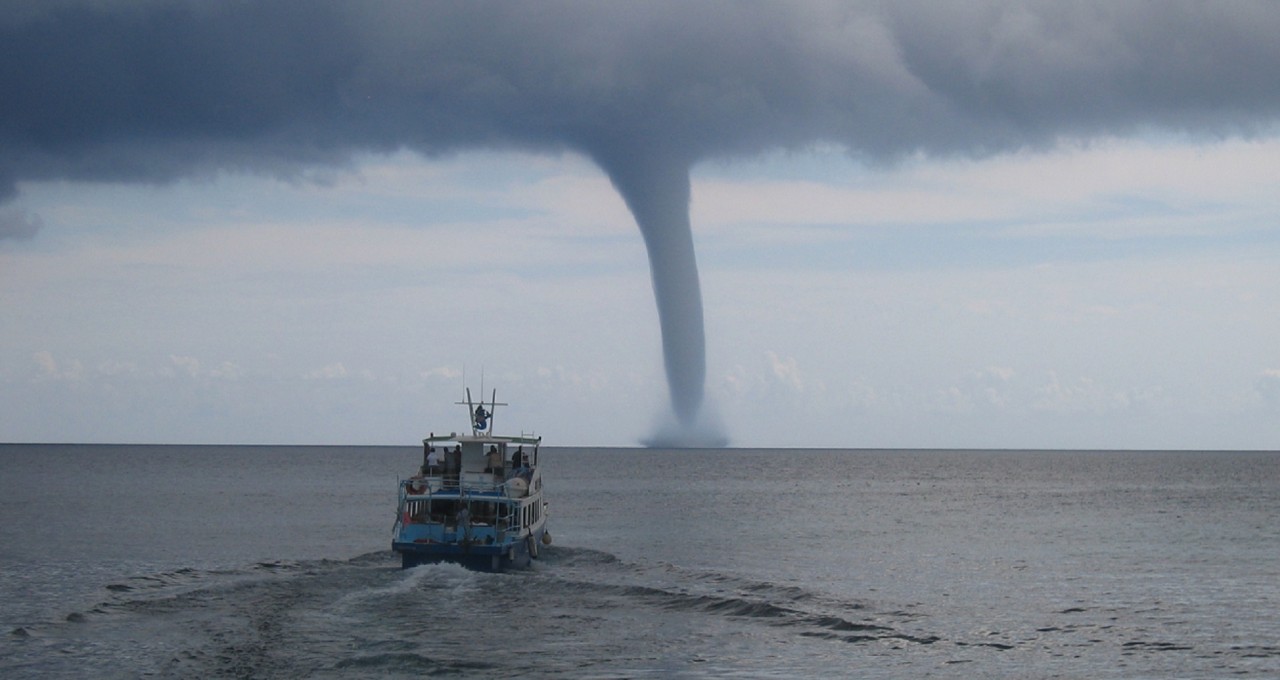热带气旋:发展和结构

热带气旋吸收热带海洋储存的热量,并将其转化为狂风暴雨和滔天巨浪,将所到之处夷为平地。热带气旋是动力与热力共同作用的产物。上图由国际空间站摄于2005年8月,以飓风“卡特里娜”为例,展示了热带气旋的形成。
1. 热带气旋的定义和气候学

根据世界气象组织(WMO)的定义,热带气旋(tropical cyclones)为“在近地(海)面较高空更为强烈的气旋性环流[1]。此类天气现象的强度可用底层风力衡量,强度不同,命名也会有所区别。“热带扰动”(Tropical Disturbance)表现为风力尚处中等强度,旋转结构大致形成,且区域内伴有持续雷暴。“热带低压”(Tropical Depression)表现为风场已形成封闭环流结构,且风速低于17 m/s (约60 km/h)。当风速介于17 m/s至32 m/s(约120 km/h)之间时,可称之为“热带风暴”(Tropical Storm)。当风速超过32 m/s时,则为“热带气旋”(Tropical Cyclone),在大西洋和东北太平洋称之为“飓风”(Hurricane),在西北太平洋则称之为“台风”(Typhoon)。气象学上通常依据最大风速或底层最低气压对热带气旋进行分类。1977年,美国学者萨菲尔(H.S. Saffir)和辛普森(R.H. Simpson)提出了包含5个等级的热带气旋等级表。
热带风暴多发于夏季和初秋,每年,全球约有80到90个热带风暴生成,其中半数可发展为热带气旋。迄今为止,气旋活动在北半球更为常见,因为位于南半球的南大西洋和东南太平洋海温相对较低,会抑制气旋形成。西北太平洋平均每年生成25个热带低压和热带风暴,其中15个会发展为台风,约占全球总数的三分之一。西北太平洋是全球唯一一处全年皆能观测到热带气旋的地区,其气旋数量在夏季和秋季达到峰值。东北太平洋平均每年生成15个低压和风暴,其中包括10个飓风。北大西洋每年平均生成10个低压和风暴,其中约有5个达到飓风级别。北印度洋的气旋数量仅占世界总量的5%,但由于孟加拉湾水深较浅,沿岸海拔较低,人口稠密,此处产生的气旋现象往往会导致重大损失。春秋两季为北印度洋热带气旋的高发季,其频率在每年5-6月和10-11月达到峰值。这是因为6-9月恰逢南亚季风盛行期,高空强风制约了气旋的发展。在南半球,西南印度洋平均每年生成10个低压和风暴,其中包括5个气旋,皆发生于夏秋季。东南印度洋和澳大利亚北部平均每年生成7个低压和风暴,并发展出3个气旋。西南太平洋平均每年生成10个低压和风暴,5个达到热带气旋水平。各地气旋数目年际变化较大,但不同海域之间往往呈现相反趋势,彼此抵消。
2. 热带气旋的形成
热带气旋扰动的发展需要特定的条件:
- 空气中的热量,以及更为重要的湿度,是气旋发展的“燃料”。因此,海洋表面温度须达到26℃以上,且水下要有至少60米深的恒温层。
- 为尽可能减少干燥空气导致的降水蒸发,并避免下沉气流(downdrafts)的形成,大气应具备较高的湿度。
- 为防止不同高度上风力与风向的变化作用于气旋性涡旋,导致其扭曲,妨碍其演变,大气应具备较弱的垂直风切变(wind shear)[2]。
- 大尺度范围内,大气呈现出低层辐合,高层辐散的特征,以促进风暴发展。
- 大尺度气旋性环流有利于风暴群结构发展。

纬度高于5-10°时,地球自转产生的科里奥利力(Coriolis force)[3]方可达到“热成风平衡”(thermal wind balance)所要求的强度。热成风平衡要求高空存在持续的暖异常(warm anomaly),并伴有强度随高度减弱的气旋性环流。扰动区域的云内水汽凝结,释放热量,因此触发强度不等的气旋性涡旋(vortex),其水平尺度范围从几十到数百公里不等。即便深对流云主体消散,由此产生的气旋性环流还可持续很长一段时间,孕育新的风暴,自身也不断增强。与此同时,海洋将热量和水汽转移至大气,源源不断为其供能,使得由下沉气流带入较低层大气的寒冷空气团消失。空气团由此逐渐变得温暖潮湿,再次催生雷暴活动。大气逐渐变暖变湿,由于蒸发冷却形成的下沉气流举步维艰,被驱至风暴团外围几百公里处。
随着多个雷暴单体(thunderstorm cells)逐步发展,在雷暴云团中心高空形成了巨大的暖异常。暖中心的热空气柱更轻,进一步加强近地(海)面低压,吸引空气低压中心辐合,产生气压梯度力。接踵而至的涡旋聚集于此,增强了气压梯度力,与科里奥利力和旋转运动的惯性离心力形成平衡。热成风平衡使得云带形成宽阔的螺旋结构(宽螺旋云系)。随着风力不断加强,气流从海洋表面摄取更多水汽与热量,而水汽与热量进一步助长了风暴上升气流,使大气增暖,加强低层低压中心,加剧涡旋。气旋性环流发展充分之时,低层出现强低压中心,激发弱下沉气流,使得空气干燥,局部云层消散,气旋的“眼区”(Eye)由此出现。
3. 能量循环和最大强度
成熟的热带气旋可视作一个热力引擎,其热量来源于水汽凝结。长期以来,人们认为大尺度雷暴造成的不稳定大气结构是热带气旋产生的源头,而事实并非如此。热带海洋大气结构通常接近正压(neutrality)状态,制约了大尺度上升运动发展。因此,气旋的能量多源于风力增强引发的海洋表面水汽蒸发。

energy loss by radiation toward space向太空辐射导致能量耗损 warm core暖中心 heating by condensation凝结生热 energy gain by humidification on ocean surface通过海洋表面的加湿获取能量 eyewall眼墙 central depression中心低压
强上升气流将云团带至大约15 km高度处,并于此处形成反气旋(anticyclonic)环流,气流由于辐散,逐渐脱离反气旋中心。同时,云体不断向太空发射热辐射,因此逐渐失去能量。而后空气团将会通过大尺度下沉运动折返回地面。在眼区中,弱下沉气流导致空气升温,加强中心低压,加大了眼区对低层外围空气的吸引力,以此确保大尺度循环得以维持。上图描述了理想状态下的热力学“卡诺”循环(ideal thermodynamic cycle “of Carnot”)。通过该机制可估测热带气旋在特定纬度、特定海洋温度,以及对流层顶高约15 km的条件下,所能到达的“最大潜在强度”(Maximum Potential Intensity),即最小压力或最大风速。估测结果与观测极端值非常契合,这表明该循环代表了热带气旋的最佳能量状态。
4. 成熟结构
然而,因为气旋内部循环的细节远比上图所示的理想状态复杂,且能量转换难以达到最佳效率,所以罕有气旋可达到最大强度。

[来源:http://www.atmos.umd.edu/~stevenb/hurr/]
气旋的“眼区”在中高空常表现为清澈干燥,下层则布满云层,水汽充沛,接近饱和状态。在低空,由于气旋性环流控制,空气向中心辐合,气团流经海洋上空,吸收海表蒸发的水汽后变得湿润。大部分湿润空气在辐合运动中滋养了飓风云体,仅有少量到达眼区。而在高空,下沉气流温暖且干燥。在强雷暴中,上升气流将外围流出的潮湿空气席卷殆尽,导致眼区出现强烈的补偿性下沉运动,使得空气趋于燥热,中心低压加强,眼区在卫星图像上清晰可见。在弱雷暴中,不利的条件致使低层湿气流渗透至眼区,令眼区趋于湿冷,空气向中心低压填充,眼区因而布满云体,在太空拍摄的卫星图像中变得朦胧。

“眼墙”由积雨云组成,围绕眼区环流中心,与之相距几十公里,表现为狭窄的螺旋云带或环型云体结构。眼墙是强垂直运动以及强降水发生区域,最大风速可达200 km/h,有时甚至超过300 km/h。热带气旋在高度几百米处风速最大,低处因受到海洋表面的摩擦力作用,风速有所减缓。在这一点上,热带气旋有别于中纬度地区扰动,后者的风速最大值出现在高空。因此,在同等强度下,热带气旋较中纬度扰动更具破坏性。
热带气旋“核心”水平尺度约几百公里,在核心内,空气围绕低压中心形成封闭环流。盘旋于在眼区周围的气旋性“初级环流”比径向气流(从外部到内部,或从内部到外部)及垂直的“次级环流”要强烈得多。近地(海)面风速受地(海)面摩擦而减慢,切向加速度因而无力与吸引空气向低压中心辐合的气压梯度力相平衡,由此产生了指向低压中心的径向加速度,从而催生上升气流。

[来源:NRL蒙特雷海洋气象司-http://www.nrlmry.navy.mil/sat_products.html]
初级环流和次级环流共同作用于气旋的演变。前者将暖中心结构,以及由此催生的低压中心同低层的强气旋性环流合二为一;后者则通过与海洋表面的摩擦,以水分的形式从海洋中获取能量,再通过水汽凝结释放热量,维持上升气流。眼区中微弱的补偿性下沉运动通过增压使得空气升温,从而维持暖中心结构。
在核心外围数百公里的区域内,水平流动不完全对称,径向风比例相应加大,导致局地出现宽约几十公里的狭长降水带,向东延伸至热带地区东风信风与气旋性环流之间的辐合带。在北半球,降水带位于热带气旋东南侧;而在南半球,降水带则位于热带气旋东北侧。
5. 结构演变
初级环流和次级环流之间的耦合机制意味着眼墙并不稳定。上升运动不仅导致眼区产生补偿性下沉运动,而且导致低层风在靠近环流中心处加速。环流中心风速加大,增加了与海洋表面的摩擦以及水汽输入,推动眼墙向内移动,致使眼墙逐渐收缩。在环流中心外围,降水带也在收缩,并发生内部下沉运动,逐渐堵塞眼墙。上述效应的结果就是眼墙逐渐消散,气旋强度暂时下降。而后外部降水带将逐渐发展形成新眼墙,气旋也再度增强。

[来源:NRL蒙特雷海洋气象司-http://www.nrlmry.navy.mil/TC.html]
在热带气旋演变过程中,一旦外部环境,如气压、风力、湿度、冷暖洋流或涡旋等发生改变,气旋的强度也将迅速发生不同程度的改变。因此,预测气旋演化困难重重,哪怕是短期预报也绝非易事。一场风暴可以在几小时内跨越萨菲尔-辛普森等级表中的整整一级,这一现象并不罕见,随着气旋强度改变,其在人口稠密的岛屿或海岸线登陆时的潜在影响也会发生剧变。
当热带气旋移至平均纬度高于30°的区域时,较低的大陆或海域温度将不足以维持其能量循环;此外,中纬度垂直风切变加大,也会扭曲其垂直结构,导致气旋减弱。小型或低强度气旋会就此迅速消散,但那些规模最大、强度最高的气旋仍能维持其结构与强度,甚至持续数日。部分热带气旋与西风环流相互作用,可演变为中纬度(斜气压)风暴(mid-latitude (baroclinic)storm)。各海域的条件不同,转变概率也不同:东北太平洋或北印度洋概率为零,西南太平洋或东南印度洋极为罕见,西南印度洋约有五分之一的概率可发生该转变,西北太平洋约有四分之一,北大西洋约有三分之一。初秋时分,原本的加勒比飓风可能会在几天后演变为欧洲西海岸的中纬度风暴。
气旋也会与地貌相互作用,发生新的演变。例如,当气旋经过大型山区岛屿,如菲律宾的吕宋岛、台湾岛,或海岸屏障,如中美洲的科迪勒拉山系,高耸的地形便会对气旋施加抬升作用,致使其发生变化。山体迎风一侧强迫暖湿空气抬升,可在当地引发大暴雨,甚至洪水和山体滑坡,常造成灾难性后果。风暴活动分布的变化可暂时破坏气旋的动力机制。有时,眼区甚至会在接近岛屿时消失,数小时后,在距离障碍物几十公里处重新出现。

[http://www.sat.dundee.ac.uk/geobrowse/geobrowse.php]

参考资料和说明
[1] 南半球为顺时针旋转运动,北半球为逆时针旋转运动。
[2] 风速或方向的垂直变化。
[3] 是运动物体在均匀旋转环境中所受的一种伪力,方向与物体的运动方向垂直。
环境百科全书由环境和能源百科全书协会出版 (www.a3e.fr),该协会与格勒诺布尔阿尔卑斯大学和格勒诺布尔INP有合同关系,并由法国科学院赞助。
引用这篇文章: ROUX Frank (2024年3月12日), 热带气旋:发展和结构, 环境百科全书,咨询于 2025年3月31日 [在线ISSN 2555-0950]网址: https://www.encyclopedie-environnement.org/zh/air-zh/tropical-cyclones-development-and-organization/.
环境百科全书中的文章是根据知识共享BY-NC-SA许可条款提供的,该许可授权复制的条件是:引用来源,不作商业使用,共享相同的初始条件,并且在每次重复使用或分发时复制知识共享BY-NC-SA许可声明。









